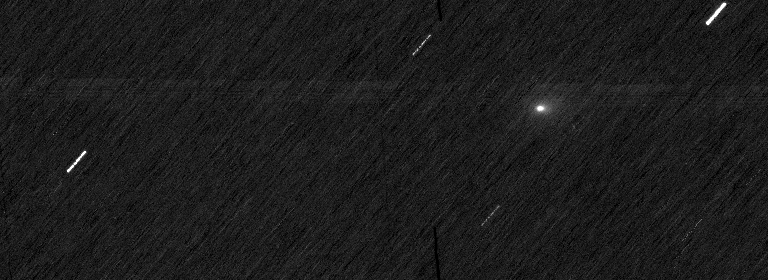Key Takeaways:
Not just another planet
HIP 65426b resembles Jupiter in size, but any comparisons end there. Not only is the exoplanet more massive than its jovian cousin, but it’s much hotter, coming in around a toasty 1,880-2,420°F (1,026-1,326°C). Based on models that match the data to simulations, the astronomers expect HIP 65426b has a dusty atmosphere, thick with clouds. The exoplanet was found at 92 AU from its star, putting it at three times the distance Neptune is from the Sun. The discovery has been detailed in a paper accepted for publication in Astronomy and Astrophysics.
“Despite more than 3,000 exoplanets discovered to date, we are far from understanding how giant planets form, which is vital as they represent the largest mass within the planetary systems they completely shape,” says Gaël Chauvin, lead author on the paper and researcher at University of Grenoble and the University of Chile. “They also play a key role in the dynamics of smaller planets similar to Earth, and therefore to ultimately understanding how life forms.”
The group of European astronomers who made the discovery has been at work in the Atacama Desert of Northern Chile at the Very Large Telescope for three years, conducting a survey of 600 young, nearby stars. Now halfway through their survey, they have discovered many potentially planet-forming disks around their surveyed stars, but HIP 65426b is the first exoplanet they have discovered. Another similar campaign, the Gemini Planet Imager Exoplanet Survey, has also only racked one exoplanet discovery to date, though multiple new disks and brown dwarfs have been found.
These results show that giant exoplanets at wide separations from their host stars are much less common than initially expected.
Picture-perfect
Taking a snapshot of an exoplanet is all but impossible for anything but the youngest and brightest exoplanets. In order for the exoplanet to show up against the blinding glare of the host star, the planet needs to be bright itself, and young planets, still radiating their own light from formation, are ideal candidates for this technique. Specialized instruments have been designed with coronagraphs, which block the light of the star and allow the astronomers to see the fainter exoplanets. Current technology limits these instruments to seeing only wide-orbit exoplanets. Consequently, this technique is thus complimentary to the more common radial velocity method, which watches for wobbles in the star’s movements and is most sensitive to giant planets on close orbits.
Unlike other young, imaged exoplanets, HIP 65426b was not observed to have an accompanying debris disk — the dusty ring around a star made up of leftovers from planet formation. At the relatively young age of 14 million years, a star like HIP 65426 would be expected to have a visible disk. The star is unique in its own regard, though; for its type, the star hosting the newly discovered exoplanet has one of the highest spin rates known, which could explain the lack of a disk. The fast-spinning system, rotating 12 times faster than the Sun, may have ejected any remaining material that would have otherwise created a debris disk.
The classical model for planet formation seems challenged by this discovery, and combined with the relatively low mass of the exoplanet and its wide orbit, HIP 65426b’s formation is not easily explained. The scientists suspect the planet formed in its current orbit, before too much material was expelled from the system due to its fast rotation. However, this scenario requires fast planet formation. An alternative theory proposes the planet could have formed closer to the star before being gravitationally pushed by another object into a larger orbit. Continued observations of the planet’s orbit may help distinguish between these theories.
“This system highlights the fact that nature is diverse and unpredictable, challenging our current theories of planetary formation,” Chauvin says.
Any major insights into the planetary atmosphere will have to wait for improved instruments. NASA’s upcoming James Webb Space Telescope, a 6.5-meter successor to the Hubble Space Telescope, will have instruments capable of probing the planet’s atmosphere in greater detail, and may even reveal the distribution of clouds as well as what they are made of. As complex optics systems are continually improved and refined, scientists will be able to image fainter exoplanets on closer orbits, giving us a fuller picture of the family of exoplanets in the Milky Way.











